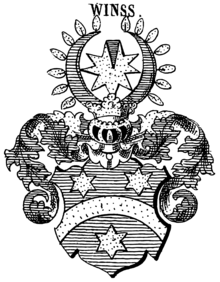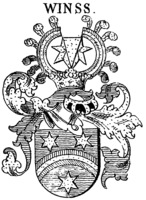Wins (noble family)
The noble family Wins (also written Wyns ) lived in Frankfurt (Oder) in the Middle Ages . Some relatives later moved to Berlin and Kölln . They became members of the royal court.
history
The safe lineage of the Berlin councilor family begins with Nickel Wyns († 1439) on Falkenberg, councilor in Berlin. Since the 16th century, the family was counted among the landed gentry.
In Berlin
A family member had a two-story city palace built as a residential building between 1378 and 1390, which was located in the courtyard area of another house at Hoher Steinweg 15. The palace is described as a “multi- vaulted stone building with a chimney”. Over the centuries, subsequent residents had the palace rebuilt and supplemented several times. In World War II it was hardly destroyed, but in 1956 after a decision by the Berlin magistrate demolished on 13 September 1950th Previously, monument preservationists had assessed the moral and historical value, which was higher than that of the Red City Hall .
The future mayor Thomas Wins emerged from the Wins family . A street in the Pankow district was named after him in 1891, and the surrounding residential area is also known as the Winsviertel .
Confirmations of nobility
- Sebastian Wynß received from Emperor Charles V on March 31, 1541 a confirmation of his knightly nobility and an improvement in the coat of arms
- Jakob Wins auf Seschwitz received recognition of his nobility from Emperor Ferdinand II. This line became extinct with Julius Friedrich in 1717.
- Gregor von Wins auf Birkenwerder and his sons Alber, Gregor and Nikolaus received confirmation of their old imperial nobility from Emperor Ferdinand II on June 1, 1631. In the same year, Margrave Georg Wilhelm von Brandenburg recognized this nobility (for the brothers Gregor and Nikolaus).
- Johann von Wins on Schützendorf, quays. War councilor and colonel, and his brother Christoph were from Emperor Ferdinand III. on May 27, 1638 raised to the free lordship of the empire and the hereditary lands.
coat of arms
In blue a golden rainbow (also divided by red, blue and gold), accompanied by three (2: 1) golden stars; on the helmet a star split by a golden thunderbolt between two golden rainbows (or multi-colored rainbows as in the shield) that form a ring open at the top, each rainbow has three golden ostrich feathers at the top and blue at the bottom. Blue and gold helmet covers
- Coat of arms variants
literature
- of wins . In: Marcelli Janecki , Deutsche Adelsgenossenschaft (Hrsg.): Yearbook of the German nobility . Third volume. WT Bruer's Verlag, Berlin 1899, p. 788-793 ( dlib.rsl.ru ).
- Family Association Ziering-Moritz-Alemann e. V., printed books of the clan association. Booklet No. 2, July 1936, p. 65 ff. ( Zma.de PDF).
- Genealogisches Handbuch des Adels , Adelslexikon Volume XVI, Volume 137 of the complete series, CA Starke Verlag, Limburg (Lahn) 2005, ISSN 0435-2408 , pp. 256-258
Comments and individual references
- ↑ a b Historic buildings - almost all large town houses and aristocratic palaces have been destroyed or demolished. But there are ideas to make their traces in old locations visible. Six examples from the old center. Picture-text contribution in the Berliner Zeitung , based on elaborations by Benedikt Goebel (Stadtforschung Berlin) and Lutz Mauersberger (Berlin-Mitte-Archiv) October 9, 2017, p. 16.
- ^ Genealogisches Handbuch des Adels, Adelslexikon Volume XVI, 2005, pp. 256-258


